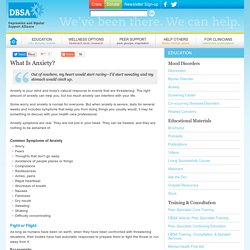

What is "Fight or Flight" and How Does it Relate to Anxiety? - Causes - Anxiety. It is impossible to read for very long about anxiety without coming across the words "fight or flight.

" What is it? And how is it associated with anxiety? The Effects of Anxiety: Symptoms, Signs, and Risk Factors. Panic Attacks Generalized Ill Health Central Nervous System Function.

Cultural Aspects in Social Anxiety and Social Anxiety Disorder. Fight or Flight Stress Response and Panic Disorder. What is the fight or flight response and how is it related to panic disorder?

How can an understanding of this response help people who are coping with panic attacks? Fight or Flight Response - Definition The fight or flight response is a physiological response to a stimulus which our bodies consider dangerous or life threatening. This response—also called the acute stress response—is familiar to most people as the intense feeling of anxiety, shaking, and fear that can occur when our bodies prepare for a possible emergency. Anxiety Disorders: Types, Causes, Symptoms, Diagnosis, Treatment, and Prevention.
What Are Anxiety Disorders?

Everyone feels anxious now and then. It’s a normal emotion. Many people feel nervous when faced with a problem at work, before taking a test, or making an important decision. Anxiety disorders are different, though. What is "Fight or Flight" and How Does it Relate to Anxiety? - Causes - Anxiety. Persistent Fear and Anxiety Can Affect Young Childrens Learning and Development. Anxiety Disorders: Types, Causes, Symptoms, Diagnosis, Treatment, and Prevention. What Are Anxiety Disorders?

Everyone feels anxious now and then. It’s a normal emotion. Many people feel nervous when faced with a problem at work, before taking a test, or making an important decision. Anxiety disorders are different, though. The Effects of Anxiety: Symptoms, Signs, and Risk Factors. Anxiety Disorders in Children. Anxiety and Depression Association of America, ADAA. Did You Know?

Anxiety disorders are the most common mental illness in the U.S., affecting 40 million adults in the United States age 18 and older, or 18% of the population. (Source: National Institute of Mental Health) Anxiety disorders are highly treatable, yet only about one-third of those suffering receive treatment. Anxiety disorders cost the U.S. more than $42 billion a year, almost one-third of the country's $148 billion total mental health bill, according to "The Economic Burden of Anxiety Disorders," a study commissioned by ADAA (The Journal of Clinical Psychiatry, 60(7), July 1999). More than $22.84 billion of those costs are associated with the repeated use of health care services; people with anxiety disorders seek relief for symptoms that mimic physical illnesses. People with an anxiety disorder are three to five times more likely to go to the doctor and six times more likely to be hospitalized for psychiatric disorders than those who do not suffer from anxiety disorders.
What is Anxiety. Out of nowhere, my heart would start racing—I'd start sweating and my stomach would cinch up.

Anxiety is your mind and body's natural response to events that are threatening. The right amount of anxiety can help you, but too much anxiety can interfere with your life. Some worry and anxiety is normal for everyone. But when anxiety is severe, lasts for several weeks and includes symptoms that keep you from doing things you usually would, it may be something to discuss with your health care professional.